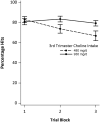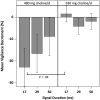Prenatal choline supplementation improves child sustained attention: A 7-year follow-up of a randomized controlled feeding trial
- PMID: 34962672
- PMCID: PMC9303951
- DOI: 10.1096/fj.202101217R
Prenatal choline supplementation improves child sustained attention: A 7-year follow-up of a randomized controlled feeding trial
Abstract
Numerous rodent studies demonstrate developmental programming of offspring cognition by maternal choline intake, with prenatal choline deprivation causing lasting adverse effects and supplemental choline producing lasting benefits. Few human studies have evaluated the effect of maternal choline supplementation on offspring cognition, with none following children to school age. Here, we report results from a controlled feeding study in which pregnant women were randomized to consume 480 mg choline/d (approximately the Adequate Intake [AI]) or 930 mg choline/d during the 3rd trimester. Sustained attention was assessed in the offspring at age 7 years (n = 20) using a signal detection task that showed benefits of maternal choline supplementation in a murine model. Children in the 930 mg/d group showed superior performance (vs. 480 mg/d group) on the primary endpoint (SAT score, p = .02) and a superior ability to maintain correct signal detections (hits) across the 12-min session (p = .02), indicative of improved sustained attention. This group difference in vigilance decrement varied by signal duration (p = .04). For the briefest (17 ms) signals, the 480 mg/d group showed a 22.9% decline in hits across the session compared to a 1.5% increase in hits for the 930 mg/d group (p = .04). The groups did not differ in vigilance decrement for 29 or 50 ms signals. This pattern suggests an enhanced ability to sustain perceptual amplification of a brief low-contrast visual signal by children in the 930 mg/d group. This inference of improved sustained attention by the 930 mg/d group is strengthened by the absence of group differences for false alarms, omissions, and off-task behaviors. This pattern of results indicates that maternal 3rd trimester consumption of the choline AI for pregnancy (vs. double the AI) produces offspring with a poorer ability to sustain attention-reinforcing concerns that, on average, choline consumption by pregnant women is approximately 70% of the AI.
Trial registration: ClinicalTrials.gov NCT01127022.
Keywords: attention; child development; choline; cognition; dietary supplements.
© 2021 The Authors. The FASEB Journal published by Wiley Periodicals LLC on behalf of Federation of American Societies for Experimental Biology.
Figures





Similar articles
-
Maternal choline supplementation during the third trimester of pregnancy improves infant information processing speed: a randomized, double-blind, controlled feeding study.FASEB J. 2018 Apr;32(4):2172-2180. doi: 10.1096/fj.201700692RR. Epub 2018 Jan 5. FASEB J. 2018. PMID: 29217669 Free PMC article. Clinical Trial.
-
Phosphatidylcholine supplementation in pregnant women consuming moderate-choline diets does not enhance infant cognitive function: a randomized, double-blind, placebo-controlled trial.Am J Clin Nutr. 2012 Dec;96(6):1465-72. doi: 10.3945/ajcn.112.037184. Epub 2012 Nov 7. Am J Clin Nutr. 2012. PMID: 23134891 Free PMC article. Clinical Trial.
-
Prenatal supplementation with DHA improves attention at 5 y of age: a randomized controlled trial.Am J Clin Nutr. 2016 Oct;104(4):1075-1082. doi: 10.3945/ajcn.114.101071. Epub 2016 Sep 7. Am J Clin Nutr. 2016. PMID: 27604770 Free PMC article. Clinical Trial.
-
Maternal choline supplementation: a nutritional approach for improving offspring health?Trends Endocrinol Metab. 2014 May;25(5):263-73. doi: 10.1016/j.tem.2014.02.001. Epub 2014 Mar 26. Trends Endocrinol Metab. 2014. PMID: 24680198 Review.
-
Assessing infant cognitive development after prenatal iodine supplementation.Am J Clin Nutr. 2016 Sep;104 Suppl 3(Suppl 3):928S-34S. doi: 10.3945/ajcn.115.110411. Epub 2016 Aug 17. Am J Clin Nutr. 2016. PMID: 27534631 Free PMC article. Review.
Cited by
-
Adaptive changes in multiple aspects of emotion regulation in the offspring of pregnant persons receiving a diet-and-exercise intervention relative to usual pregnancy care: a randomized controlled trial.Am J Clin Nutr. 2025 Jan;121(1):50-59. doi: 10.1016/j.ajcnut.2024.10.022. Epub 2024 Oct 30. Am J Clin Nutr. 2025. PMID: 39486684 Clinical Trial.
-
Inadequate Intake of Choline and Essential Fatty Acids in Latin American Childbearing-Age Women as a Regional Pre-Conceptional Disadvantage: ELANS Results.Nutrients. 2024 Sep 18;16(18):3150. doi: 10.3390/nu16183150. Nutrients. 2024. PMID: 39339751 Free PMC article.
-
Choline-An Underappreciated Component of a Mother-to-Be's Diet.Nutrients. 2024 Jun 5;16(11):1767. doi: 10.3390/nu16111767. Nutrients. 2024. PMID: 38892700 Free PMC article. Review.
-
The Importance of Gut Microbiota on Choline Metabolism in Neurodegenerative Diseases.Biomolecules. 2024 Oct 23;14(11):1345. doi: 10.3390/biom14111345. Biomolecules. 2024. PMID: 39595522 Free PMC article. Review.
-
Perspective: Promoting Healthy Aging through Nutrition: A Research Centers Collaborative Network Workshop Report.Adv Nutr. 2024 Apr;15(4):100199. doi: 10.1016/j.advnut.2024.100199. Epub 2024 Mar 1. Adv Nutr. 2024. PMID: 38432592 Free PMC article.
References
-
- Zeisel SH, Mar MH, Zhou Z, da Costa KA. Pregnancy and lactation are associated with diminished concentrations of choline and its metabolites in rat liver. J Nutr. 1995;125(12):3049‐3054. - PubMed
Publication types
MeSH terms
Substances
Associated data
Grants and funding
LinkOut - more resources
Full Text Sources
Medical
Research Materials

